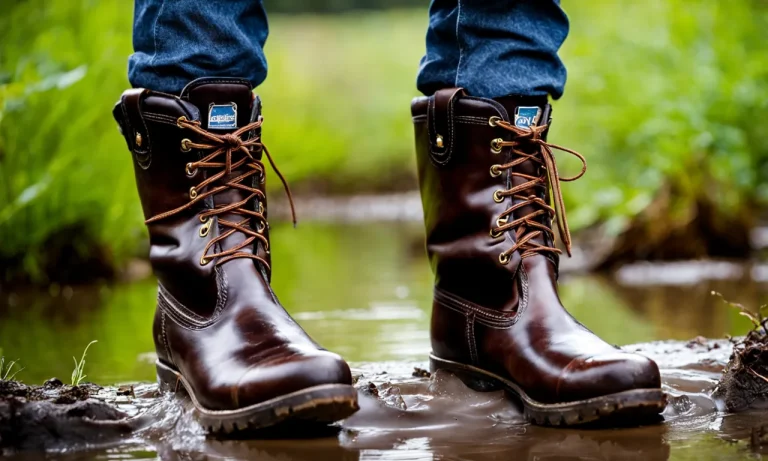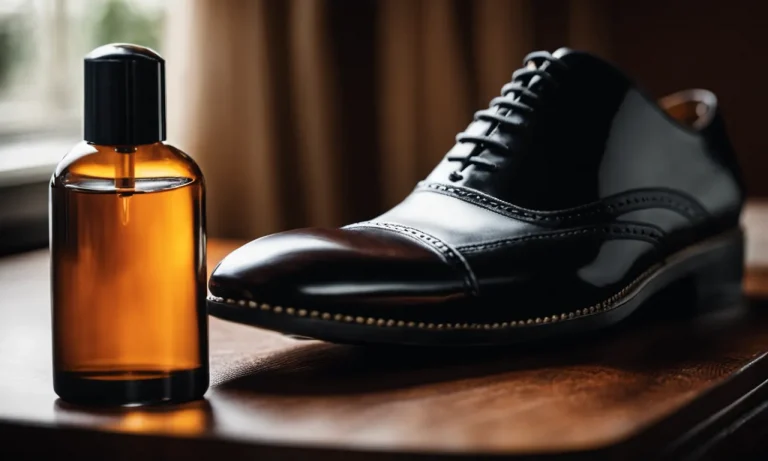If you have a pair of boots that feel loose around the ankles, it can be annoying and unsafe. A loose boot often rubs and causes blisters, and can even slide off while you’re walking. Luckily, there are several easy ways to make your boots fit more snugly around the ankles without having to buy a new pair.
If you’re short on time, here are some quick tips: wear thick socks, use fashion tape on the heel, or lace the boots differently by criss-crossing or looping the laces. Read on and we’ll go over these tricks and more in detail.
Wear Thicker Socks
One simple and effective way to make your boots tighter around the ankle is to wear thicker socks. Thicker socks can add extra padding and bulk to your feet, which can help fill up any empty space inside the boots and provide a snugger fit.
There are different types of thicker socks you can try, including cotton socks and wool socks.
Cotton Socks
Cotton socks are a popular choice for many people due to their comfort and breathability. They are lightweight and can help absorb moisture from your feet, keeping them dry and comfortable. When it comes to making your boots tighter around the ankle, cotton socks can provide some padding and fill up any empty space, resulting in a tighter fit.
However, keep in mind that cotton socks may not provide as much insulation in colder weather compared to wool socks.
Wool Socks
Wool socks are an excellent option for making your boots tighter around the ankle, especially in colder climates. Wool is a natural insulator and can help keep your feet warm even in freezing temperatures.
Additionally, wool socks are thicker and provide more padding compared to cotton socks, making them ideal for filling up any empty space inside your boots. They also have moisture-wicking properties, which can help keep your feet dry and prevent any discomfort or blisters.
When choosing thicker socks to make your boots tighter around the ankle, consider the thickness, material, and comfort level. It’s essential to find a balance between a snug fit and comfort, as overly tight boots can cause discomfort and foot pain.
Experiment with different types of socks and find the one that works best for you.
Use Fashion Tape
If you have a pair of boots that are slightly loose around the ankle, one simple and effective way to make them tighter is by using fashion tape. Fashion tape is a double-sided adhesive tape that is commonly used in the fashion industry to keep clothing in place or make adjustments.
It can also be used to provide a temporary solution for loose boots.
How to Apply Tape
Applying fashion tape to your boots is a straightforward process. Here’s how you can do it:
- Start by cleaning the area around the ankle of your boots to ensure proper adhesion.
- Cut a small piece of fashion tape, about an inch or two in length.
- Peel off the backing from one side of the tape and place it on the inside of your boot, near the ankle area.
- Peel off the backing from the other side of the tape and press the two sides of your boot together, creating a tighter fit around the ankle.
- Repeat the process on the other boot if necessary.
Note: It’s important to remember that fashion tape is a temporary solution and may not provide a permanent fix for boots that are significantly too loose.
Types of Tape
When it comes to fashion tape, there are several types available on the market. Here are a few options you can consider:
| Tape Type | Features |
|---|---|
| Double-sided tape | Provides a strong hold and is suitable for most fabrics. |
| Medical tape | Offers a secure hold and is hypoallergenic, making it suitable for those with sensitive skin. |
| Transparent tape | Blends well with most fabrics and is virtually invisible when applied. |
It’s important to choose a tape that is suitable for your specific needs and the material of your boots. Experimenting with different types of tape can help you find the one that works best for you.
Remember, fashion tape is a quick and temporary fix. If you find that your boots are consistently loose around the ankle, it may be worth considering other options such as using an insole or visiting a shoe repair professional.
Lace the Boots Differently
One of the easiest ways to make your boots tighter around the ankle is to lace them differently. By trying out different lacing techniques, you can achieve a snug fit that will prevent your ankles from sliding around inside the boots and ensure maximum comfort while walking or hiking.
Criss-Cross Lacing
Criss-cross lacing is a popular technique that can help tighten your boots around the ankle. Start by inserting the lace through the bottom eyelets, making sure the ends are of equal length. Cross the laces over each other and insert them into the next set of eyelets.
Continue this pattern until you reach the top of the boot, pulling the laces tight as you go. This method provides a secure fit and can be adjusted to your desired level of tightness.
Loop Lacing
Loop lacing is another effective technique to make your boots tighter around the ankle. Begin by lacing the boots normally until you reach the second-to-last set of eyelets. Instead of crossing the laces over each other, thread them vertically through the eyelets, creating loops on either side.
Then, cross the laces over each other and insert them into the last set of eyelets. This method allows you to adjust the tightness around the ankle by tightening or loosening the loops.
Remember, finding the right lacing technique may require some trial and error. Experiment with different methods to find the one that works best for you and provides the desired level of ankle support and tightness.
Use Boot Straps
One effective way to make your boots tighter around the ankle is by using boot straps. Boot straps are adjustable straps that wrap around the ankle area of your boots, providing a tighter fit. These straps can be made of various materials, such as leather or fabric, and come in different styles to suit your preference.
How to Use Boot Straps
Using boot straps is relatively simple. Here’s a step-by-step guide:
- Start by lacing up your boots as you normally would.
- Wrap the boot strap around the ankle area of your boots, making sure it is snug but not too tight.
- Fasten the strap securely using the buckle or any other fastening mechanism provided.
- Adjust the tightness of the strap to your desired level of comfort.
Boot straps not only help make your boots tighter around the ankle, but they also add a stylish touch to your footwear. You can find boot straps in various colors and designs, allowing you to personalize your boots and make a fashion statement.
Additional Tips
Here are a few additional tips to consider when using boot straps:
- If your boots have multiple straps, adjust each one separately to ensure an even fit.
- Experiment with different strap positions to find the most comfortable and secure fit.
- Consider using thicker boot socks or adding padded insoles for added ankle support and snugness.
Remember, boot straps are a great accessory for tightening your boots around the ankle, but they may not completely solve the issue if your boots are too loose or ill-fitting. If you find that your boots still feel loose even with the use of boot straps, it may be worth considering getting your boots professionally fitted or exploring other options to ensure a comfortable and secure fit.
For more information on boot straps and where to purchase them, you can visit websites like www.bootstraps.com or www.bootaccessories.com.
Have a Cobbler Add Padding
If you’re struggling with boots that are too loose around the ankle, one effective solution is to have a cobbler add padding. A skilled cobbler can add extra padding to the inside of your boots, creating a more snug and comfortable fit.
Padding can be made from a variety of materials, including foam, felt, or leather. The cobbler will carefully measure the circumference of your ankle and determine the appropriate amount of padding needed to achieve the desired fit.
They will then insert the padding in strategic areas to fill any gaps and provide additional support.
Not only does adding padding tighten the ankle area, but it can also help alleviate discomfort and prevent blisters that may occur from the boots rubbing against your skin. It’s a simple and practical solution that can significantly improve the fit and feel of your boots.
Why Choose a Cobbler?
While there are DIY solutions available, such as using heel grips or insoles, consulting a professional cobbler is often the best option. Cobblers have the expertise and experience to assess your boots and make precise adjustments that will not compromise their structural integrity or aesthetics.
Additionally, cobblers have access to high-quality materials and tools that may not be readily available to the average consumer. By entrusting your boots to a cobbler, you can be confident that the padding will be of the highest quality and will last for a long time.
Where to Find a Cobbler
When searching for a cobbler, it’s important to choose a reputable and skilled professional. You can start by asking for recommendations from friends, family, or even local shoe stores. Alternatively, you can search online directories or platforms that specialize in connecting customers with trusted cobblers in their area.
Before committing to a cobbler, consider reading reviews and checking their credentials, such as certifications or years of experience. It’s also a good idea to inquire about their pricing and turnaround time to ensure it aligns with your expectations.
Remember, a cobbler can be a valuable resource for keeping your boots in great condition and ensuring a comfortable fit. Don’t hesitate to reach out to one for assistance with adding padding or any other boot-related repairs or alterations.
Conclusion
With a few simple tricks like wearing thicker socks, using fashion tape, adjusting your laces, and adding padding, you can easily make loose boots fit more snugly around your ankles. Taking the time to get the right fit will prevent blisters and keep your boots secure as you walk.
If none of these do-it-yourself solutions work, it may be time to replace your boots with a better fitting pair.






